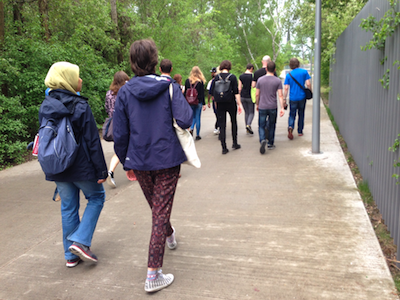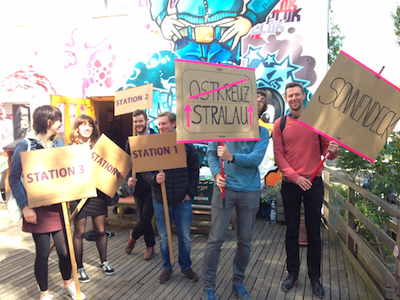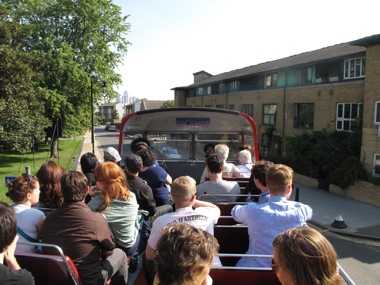In early May 2015, thanks to funding from DAAD, a group of the Urban Studies MSc students convened in Berlin for a varied week of architecture tours, urban practice workshops, urban nature and bright German spring weather.
The pivot of the week, and its ostensible motivation, was a three day workshop organised by the Technische Universität as part of the Urban Lab+ network. The workshop was grappling with the problem of practice-orientation in urban education. Before getting to grips with that, though, the group got stuck into some urban education itself. That started with dinner on Sunday night.
.JPG)
In the process of walking many miles around the city over the week the group were treated to the insights of a variety of Berliner MSc students past and present. This began with a walk around the neighbourhood of Schillerkiaz led by Hanna Hilbrandt (MSc Urban Studies 2011-2012). Walking through the area Hanna gave an introduction to the drivers of and restraints on gentrification which have characterised changes in the area over the last decade. The neighbourhood borders the huge Tempelhof airfield, recently guaranteed for the city as a park by a popular referendum. An overview of the activism, process and politics of the referendum gave some of the students shivers of jealousy in contrast to London’s urban politics (an impression tempered by Matthew Gandy’s description a few days later of the more familiar corporate shenanigans imposed on the same referendum process when applied to Berlin’s energy system). The wide windy space of Tempelhof is set off by the extraordinary art deco-cum-national socialist span of the airport building itself. A half-hearted attempt to infiltrate the building came to an early end and the group headed to the U-bahn.
.JPG)
The afternoon was curated by the firm hand of Jim Hudson, a current student. Jim lead the group around West Berlin’s weird and wonderful collection of late 20th century architecture, sharing his voluminous knowledge of the Internationale Bauausstellung (IBA) which guided the development of much of West Berlin from its inauguration in 1957 until the 1990s. Without a shred of favouritism in sight Jim outlined the IBA’s ambition, scope and design quality, before explaining its more recent downfall into a sanitised form of neoliberal urban governance and baroque nostalgia.
.JPG)
A tone of more restrained disappointment – coupled with genuine excitement and positivity – could be discerned occasionally in Tuesday’s activities. Matthew Gandy took the group on a sinuous path around the city’s urban nature. We started at the award winning Nordbahnhof park, a strip of careful ecological artifice along the route of the old Berlin wall. From there we walked to a destroyed site at the heart of Matthew’s previous research; a rubble meadow landscape now replaced with a somewhat sinister development of luxury flats apparently unironically called ‘The Garden’. Hoardings covered in smiling perfect couples, waxy flowers and foot-long bees lined the road where rare grasses and actual bees used to be. A park or two later the tour finished in the late afternoon in the enigmatic Natur-Park Schöneberger Südgelände, a landscape of cast iron walkways among urban woodland growing over a former railway sidings. After more lepidoptera than many of the group consider in an ordinary day, we dispersed again.

Wednesday morning was something of a hard landing into practice-orientation in the austere modernist surrounds of TU Berlin’s Architecture department. Seated precariously on pop-up cardboard stools the group listened to presentations and discussions of the role and scope of practice-orientation in urban education. Interesting insights and examples came from Johannesburg, Berlin, Lisbon and London.
The latter half of the week was an expansion on the theme of practice-orientation. On Thursday an encompassing walk around Ostkreuz culminated in the group taking part in a student project to propose transitional uses for an un-preposessing triangle of land between a cluster of un-finished and uncertain infrastructure projects. The TU Berlin students were hosting a meeting to present initial ideas to the community. On Friday further workshops in the morning gave the opportunity for the group to take part in practice-oriented learning, including in photographic methods from Johannesburg and case studies from London. After a contrasting tour of Prenzlauer Berg – an area much more gentrified than Ostkreuz of the day before – the week culminated in a debate and panel at the AEDES Metropolitan Laboratory on ‘The Politics of Practice Orientation’.

The week was a balanced and immersive sweep through the urban politics and aesthetics of Berlin. The MSc group were lucky to hear from both new and experienced voices from near and far working in and on Berlin. It was, too, an insight into the work of the Urban Lab+ network, grappling with its questions of urban education and practice. After nine months of London, the trip to Berlin was, therefore, a welcome source of perspective, challenge, relief and intellectual excitement.
Text: Archie Davies (Urban Studies student 2014-15)
Photographs: Andrew Harris and Jacob Fairless Nicholson



